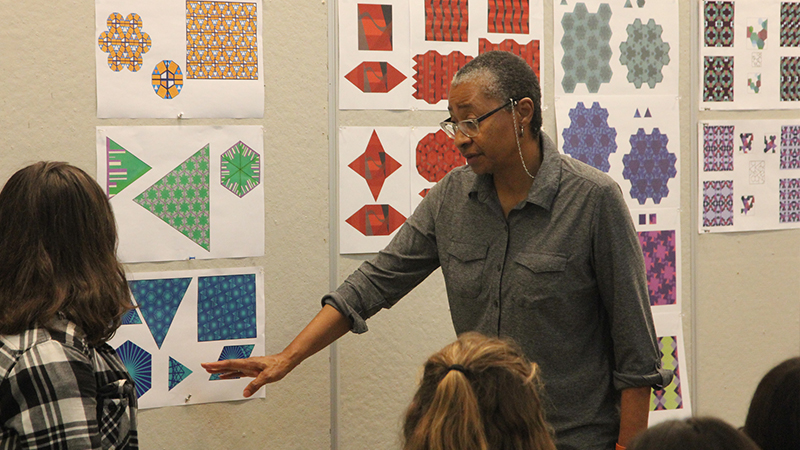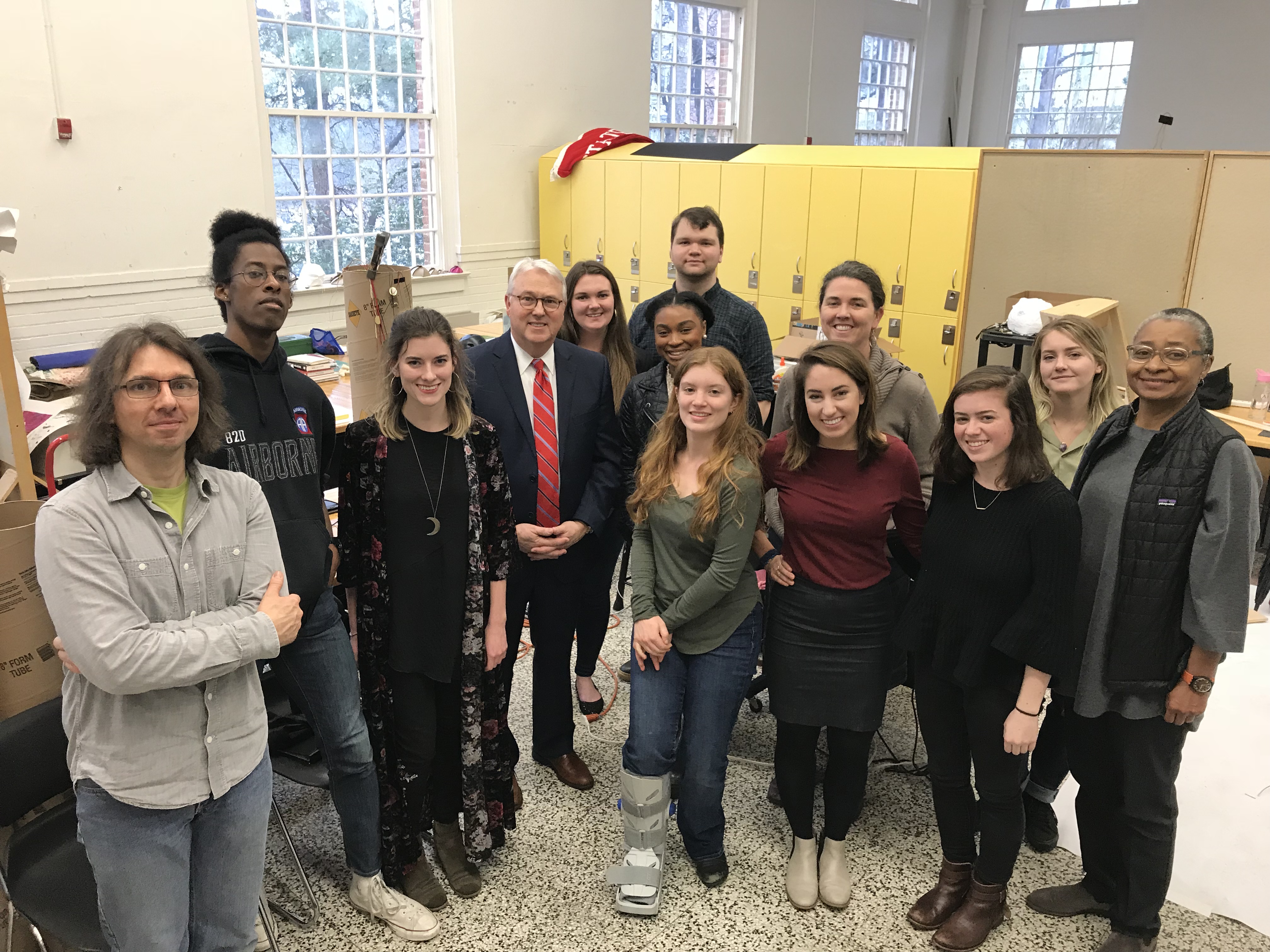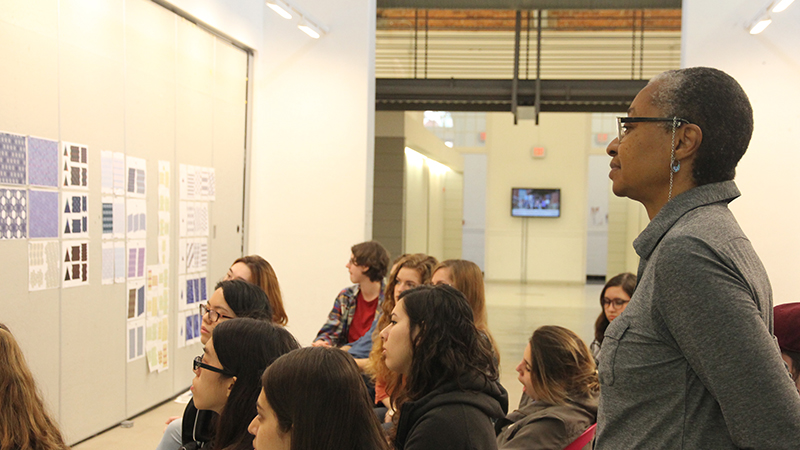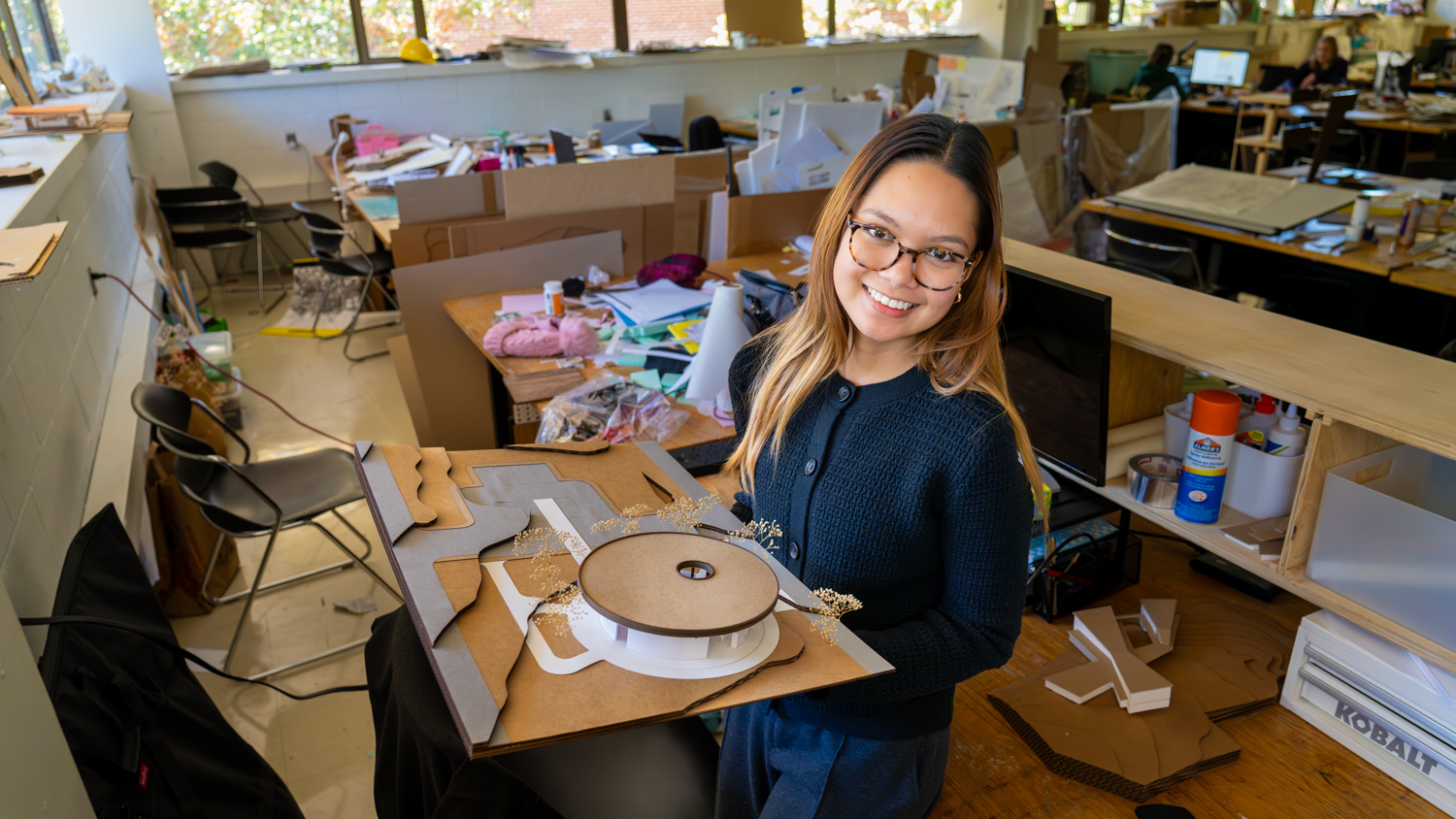A Deserving Retreat

Head of the Department of Art + Design and Alumni Distinguished Professor of Art + Design Chandra Cox has taught at NC State for over 36 years. She has seen many changes in the College and design curriculum in her tenure, but at the heart of design, she believes, will always be the core design fundamentals of painting and drawing because designers are makers.
Cox is herself a practicing artist. She is an image maker who works in a range of mediums from acrylic to digital media. Her recent projects are large-scale 3-D works of public art for the Charlotte Area Transit System in Charlotte, North Carolina.
Cox began teaching at NC State as an assistant professor in 1981. In 2001, Cox took on an administrative role as department head of Art + Design. She has served in this role for 17 years, and at the end of June, she will retreat from this position. We recently spoke with Cox about how time and technology have affected design, the development of the Design Studies program, and what her plans for the future are.
Q: As head of the Art + Design program, do you identify equally with art and design, or do you see yourself leaning more towards one or the other?
Cox: By nature, I am an artist. That is why we implement the identification of artist-designer because there are a lot of people that operate from that space. But you have to be true to your heart—in my heart, I am an artist. Although, I love design. I made that big transition to designer upon coming here to teach.
When I came here in 1981, the design fundamentals was the core of the College and every undergraduate student that came into the College took two years of design fundamentals. My colleagues were people like Charles Joyner, Joe Cox, Wayne Taylor, Michael Pause, Ron Rozell, George Bireline, Jim Starrett, Dana Raymond, Lope Max Diaz, Susan Brandeis, Marianetta Porter, and Susan Toplikar; the list goes on. Susan Brandeis came a year after me, and Susan Toplikar was one of the first females on the faculty at NC State. We were responsible for teaching Design Fundamentals 101 and 102.
Those were the glory years. We were teaching painting, drawing, sculpture, color, light, and geometry. All of the students, it didn’t matter whether they were studying Architecture or Industrial Design (at the time it was called Product Design)—it didn’t matter the discipline—they all studied with us. That is why so many of the alums from the ’80s and ’90s were my students; I had them in fundamentals studio or they took painting or drawing.
I was hired to teach drawing, primarily, but I also eventually taught painting. As I teach drawing and design, I’ve come to realize the close relationship between drawing and mathematics, which is ironic because I have a block with math, except when I’m drawing. I do a lot of translation of that with my students when I’m teaching drawing, so that math makes more sense. We use it as a language, an instructional language, which is very useful in many regards. I only wish I was better at math so I could push those relationships further. But, then there are a lot of people around me that are good at math, so I use their skills. I use them to break it down.
Painting, drawing, and geometry are the core of design. They still are, even though they have been pushed more to the fringe, giving priority to the thinking and the research. I think it is a sign of the times, a trend. At the core of design is makers. We are makers. Surely people can analyze; it gives more information to make a better product, but we are makers.
Q: Were you influenced by anyone to take up art or design? Or is your interest and creativity innate?
Cox: Oh, it is innate. It was recognized early by my parents. My mother would draw with me. We lived in Nebraska, and they had a state law that you had to be 5 to enter kindergarten. My birthday is in November, so that would have put me a year behind. It just so happened that my father was teaching part-time at the University of Nebraska, and I was in their preschool. They recommended that I take a test to qualify to enter kindergarten early. Most of the test was based on spatial perception, and I aced it. So, I went to kindergarten at 4 years old.
I’ve always been able to draw, and I’ve always drawn. When you are born with it, you just come out doing it. It’s not like someone teaches you; you can just do it.
Q: What inspires you to mentor and nurture students on their paths as designers and creatives?
Cox: I’m a third-generation educator. My mother and father were both educators—my mother taught high school and my father taught at the University of Nebraska and at the Catholic University of America in Washington. My maternal grandmother was a teacher and my grandfather was a minister; so, that’s third generation. And now my niece is teaching as well; she is the fourth generation. She teaches music in an elementary school in Charlotte.
Q: You have been teaching for over 36 years. What motivates you to continue teaching for such a long period of time?
Cox: There are a couple things—being in an academic environment, you can’t help but be a lifelong learner. You learn from students as well as from the technologies of the time. This forces you to remain current and to be continuously engaged, and you are learning all the while. But then, ultimately, the output is what is so inspirational—making things and seeing those things come to life—the larger it is, the more impressive.
My newest adventure is in the public art arena. I’ve been doing this for 10 years, and we just completed the project, the Blue Line Extension in Charlotte. This is a whole new line (the blue line) for the Charlotte Area Transit System, and the debut will be in March. It is the largest scale project for me and is truly public art. It is there for millions to participate in or to use. I am proud of this, and I have to say that I have collaborated with my good friend Susan Cannon. That is the beauty, another one of the beauties, to be here at the College of Design. You get to meet an array of amazing professionals and find situations in which you can collaborate, and I really enjoy that.
Q: Can you share one of your most memorable moments with an individual student or with a faculty member?
Cox: One that immediately comes to mind is Jason Carpenter. He fashioned himself as a painter. He was all in. That was when we had painting studios, and he would be over there all the time painting. We had just recruited Pat FitzGerald, and Pat’s use of digital technology was new to the College of Design because there previously wasn’t a real strong digital presence here. We were still teaching painting, but we wanted to introduce digital technology as a core skill to the College at large.
Pat and I were team-teaching Intro to Animation. Jason Carpenter was taking the class, and he needed the class to graduate. Jason was resistant to the computer. He hated it. I was the department head at the time, and I remember one day, Jason was in the lab lying down in front of the computer in protest. He was not going to touch it. He had his head down on the desk in front of the keyboard. So I walked over to Jason and I told him, “Jason, I know you don’t want to do this, but you have to do this because if you don’t pass this course, you are not graduating.” I told him straight up.
Jason protested that whole semester. We were weeks out from the end and were like “You have got to rally. You have got to find your way. This is the future. You have got to embrace it.” He was tremendously skilled. He was a tremendous illustrator. He drew beautifully; he painted beautifully. It’s different when you are mixing paints and applying it—it’s that physicality, that rapport or relationship with that medium. You don’t cozy up to your computer; its results can be amazing, but you have to acquire that love or appreciation for it and make the adjustment.
Many years later, Jason won an Emmy for his digital illustration for “He Named Me Malala.” It’s his career. His whole career is based around animation, digital animation, digital illustration.
Q: You have been the department head of Art + Design for 17 years. What are you most proud of in your tenure as department head?
Cox: I would say Design Studies. I was the third option for developing Design Studies. I got it and ran with it… and now, its equal in size to Art + Design studio and growing.
The principal idea behind developing Design Studies is that we left too many students on the table—applicants that were interested in design but didn’t have the competitive skill set to get into design, plus the restricted number of seats available. I’ve been involved in the administration process for years, and I’ve seen a lot of students be denied access to the College of Design. The Design Studies discipline offers any student the opportunity to be exposed to design. This is my premise. This is an opportunity. An expansion.
Design Studies has concentrations with the College of Management—a concentration in Business Administration or a concentration in Nonprofit Studies. And we just established three rollovers with concentrations within the College of Design—Design Studies with a concentration in Architecture, which is a faster track to the Architecture master’s program, directly from Design Studies, and Design Studies with a concentration in Landscape Architecture, which helps students since Landscape Architecture doesn’t have an undergraduate program. This concentration is a faster or direct track from a Design Studies undergraduate program, enabling students to take courses in Landscape Architecture and better prepare them for the master’s program. And last but not least, Design Studies with a concentration to fast-track to the master’s in Art + Design. My original idea with this rollover was to help, particularly, our transfer students from community colleges. They come in with so many GEP s completed, that they don’t have enough time to really get the in-depth experience or immersion in design that they need. This is an opportunity for them to spend time in the discipline of design, and in the end come away with a bachelor’s as well as a master’s.
This is good for everybody, even for our majors who enter as freshman and, just from their exposure, they become more and more curious about what is being done in the master’s level. This is a direct track for them to get into the master’s program and to get more involved with research efforts. I am very proud of that curricular development.
I learned as a department head that I enjoy writing curriculum. I see this as one of my strengths. I developed Design Studies, and I have strengthened and expanded the program of Art + Design studio curriculum. I made a point, that digital technology was one of the core components to the Art + Design’s curriculum, and that all Art + Design majors would be as digitally literate as possible. I made sure they would touch all the digital technology that we have in this College. I want them to graduate with that fundamental knowledge as a part of their toolbox or toolkit. This gives them a great advantage, a tremendous advantage, in the workplace.
Q: As you prepare for your retreat from this administrative role, what are you most looking forward to?
Cox: I am looking forward to spending more time teaching, as well on as my own personal work—public art, commissions, or more individualized personal expressions. My real big challenge is becoming more digitally literate. You get spoiled as an administrator; you are surrounded by people who have all these talents. They do things much faster than you, and they assist you. You can really become an elephant and get behind. I admit, I am not the most digitally literate person. I am baseline digitally literate. I recognize my deficit, and this is something I look forward to rectifying.
Q: Why is now a good time to retreat?
Cox: Well, 17 years is a long-time. It’s a new administration, meaning there are going be a lot of changes and adjustments. I’ve been doing this a long time. You never know how much time you have. I want to give the time and energy that I do have left to the things that are more of interest to me, to my liking and personal expression. My time is limited and so I have to maximize this. Sitting here and solving this department’s problems, to the extent that they keep you up at night, that creative resolution is over for me. The time is run out on this; I don’t have the energy, interest, or capacity to address these issues with the same zeal that I had 17 years ago. Or even 10 years ago.
So, it was a good time. It was always my intention that once there was a change in leadership, I was going to be in place for a year, for the new leadership to adjust, but after that, it is a good time to retreat.
I hope to still teach sophomore studio, primarily drawing. It depends on what the new department head agenda is. If we are able to do product development studios or upper-level studios, I am open to that. I am open to teaching freshman Art + Design studios.
Painting, drawing, and geometry are core to profession design expression—this is still true. Surely, you can develop upper-level studios based on the same core content. It shouldn’t be relegated just to foundational or core studios. I really feel that a lot of that is missing now; there are other priorities. But as long as we are makers, we need to be concerned with the quality and efficiency of the form that we design.

Staci Kleinmaier is a professional writer and photographer living in Apex, North Carolina. She uses words and images to tell stories. To see her work, visit www.stacikleinmaier.com.
- Categories:



